-
1 of 253523 objects
Fernando Alvarez de Toledo (1507-1582), 3rd Duke of Alba c.1555
Bronze | 96.5 x 63.0 x 33.5 cm (whole object) | RCIN 35337
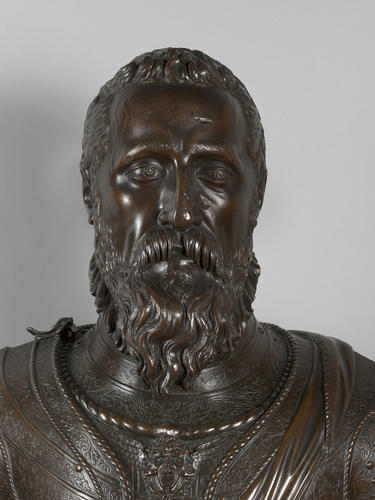
Leone Leoni (1509-90)
Fernando Alvarez de Toledo (1507-1582), 3rd Duke of Alba c.1555
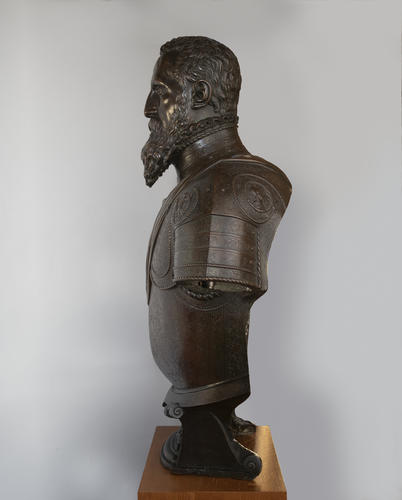
Leone Leoni (1509-90)
Fernando Alvarez de Toledo, 3rd Duke of Alba, (1507-1582) c.1555
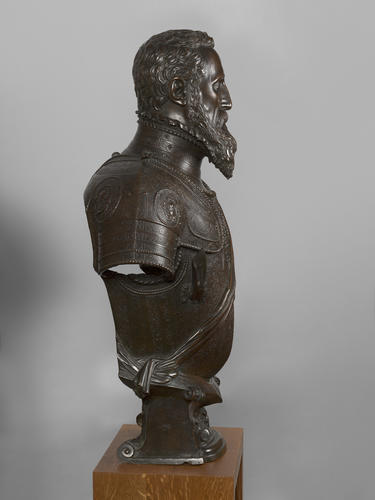
Leone Leoni (1509-90)
Fernando Alvarez de Toledo (1507-1582), 3rd Duke of Alba c.1555
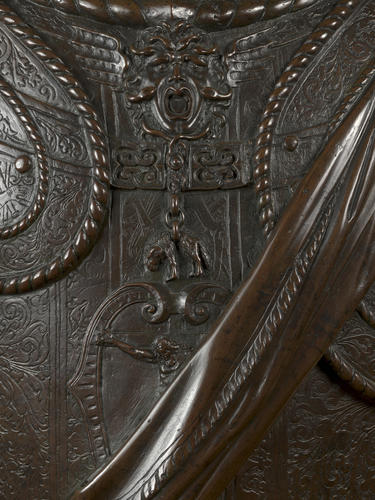
Leone Leoni (1509-90)
Fernando Alvarez de Toledo (1507-1582), 3rd Duke of Alba c.1555
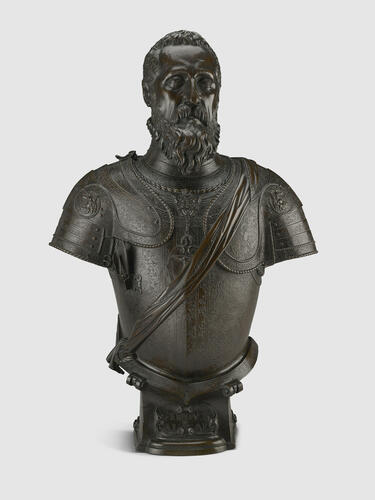

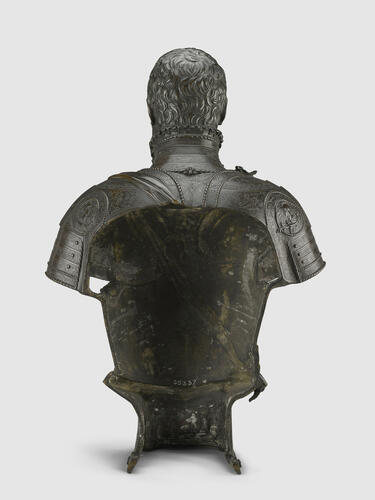



-
An Italian bronze bust of the Duke of Alba, wearing elaborately engraved and chased armour, with the collar and badge of the Order of the Golden Fleece and a sash across the left shoulder. The head faces forwards and the lightly incised eyes gaze straight ahead. The face is long and somewhat drawn, with flatly modelled hair, raised eyebrows, high cheekbones and hollow cheeks ending in a luxuriant beard and moustache. The collar of the Golden Fleece is worn underneath the pauldrons so that only the two crisply modelled central links are visible. From them hangs the badge of the Order and below that is an oblong cartouche enclosing a relief of the crucifixion. Inscribed in a cartouche on the integrally-cast socle FER . DUX / ALBAE.
Ferdinando Alvarez de Toledo, 3rd Duke of Alba (1507-1582) was for decades the leading general, statesman and adviser of the Habsburg Empire, serving both Charles V and his son Philip II, from 1567-1573 as governor of the Spanish Netherlands. He was also connected with the transatlantic slave trade and supported it politically.
For this powerful portrait Leoni has clothed the duke in precisely the same armour as is worn by Charles V and Philip II (RCINs 35323 and 35325) in their busts from the same commission, portraying the three men as warrior-comrades with no distinction as to rank, united in a crusade; this impression is heightened by the Christian badge each wears in the centre of his armour. Technically superb, the three busts share several striking features. All three are in the distinctive format favoured by Habsburg rulers, with naturalistic heads applied to empty, armoured torsos, although here the integral socles are minimally modelled, as distinct from the allegorical, figurative supports found on other busts of this kind. The armours worn by all three sitters, and all aspects of the presentation of the busts are essentially identical, despite the significant difference in the status of the three subjects. The design and treatment of the armour is painstaking and authentic in the details.
The three busts were commissioned by the Duke of Alba, probably for the gallery in his castle at Alba de Tormes near Salamanca in Spain, where they were noted in 1788. The inscription on the bust of Philip II (RCIN 35323) identifies him as ‘King of England’, which serves to date that bust (and so probably all three) to around 1554, when Philip married Mary Tudor. The Duke of Alba served as governor of Milan in 1555–6, which provided an opportunity for a commission to the most eminent sculptor of that city, Leone Leoni. There is a record of a single payment from the duke to Leoni dating from January 1558, for 160 scudi, which seems both too little and too late for the three busts, but it may have been the last of a series of stage payments.
Whereas the portraits of Charles V and Philip II are based on models which Leoni used several times, this bust of the duke himself is unique. Thus of the three busts, this is the only one that would have required sittings, since the likenesses of the other two follow so closely those of earlier portraits. The most likely date for these sittings and for the commission would seem to be following the duke’s
appointment in April 1555 as captain general in Italy, governor of Milan and viceroy of Naples and prior to Philip II’s accession to the crown of Spain in January 1556.
At the 1825 sale of the rapidly assembled and spectacular collection of George Watson Taylor the busts were acquired, with twenty-seven other lots, by George IV for his new apartments at Windsor Castle. It seems certain that the three busts had been removed from one of the properties of the Dukes of Alba during the Peninsular War; either from Alba de Tormes, where they were described as late as 1800, or perhaps from the Palacio de Liria in Madrid. They had been purchased by Watson Taylor in Paris.
Replicas of all three busts - Charles V, Philip II and the Duke of Alba - were made during the Second World War by J. Galizia of 36 York Road, Battersea, London, for the then Duke of Alba during his term (1939–45) as Spanish ambassador to London.
Text adapted from Sculpture in the Collection of His Majesty The King (2025)Provenance
Commissioned by Fernando Alverez de Toledo, Duke of Alba (1507–82); at the castle of Alba de Tormes near Salamanca in 1800; George Watson Taylor sale, Christie’s, 28 May 1825, lot 69; bought by
Fogg for George IV, £47 5s; sent to St James’s Palace, June 1825 ‘to be kept in store’; sent to Windsor Castle 12 November 1828; placed in the Grand Corridor; Queen’s Guard Chamber by 1915. -
Creator(s)
(sculptor)(nationality)Acquirer(s)
-
Medium and techniques
Bronze
Measurements
96.5 x 63.0 x 33.5 cm (whole object)
Category
Object type(s)